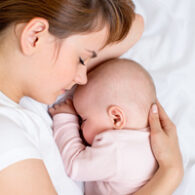Colic-Causing Foods to Watch For
Mother-infant dining partners can enjoy a bountiful menu. But some babies are sensitive to certain foods in mother’s diet (See What’s Colic? Does Your Baby Have Colic? How to Tell). Colic-causing foods can enter your breast milk and upset your baby. This can happen as early as two hours after you ingest the colic-causing food. A clue to food sensitivities as a cause of fussy, colicky behavior is a pattern called twenty-four-hour colic. This term describes a hurting episode that occurs within twenty-four hours after the breastfeeding mother eats a colic causing food(s).
Dairy products
Potentially allergenic proteins in dairy products enter breast milk and produce colicky symptoms in babies.
Caffeine-containing foods
Soft drinks, chocolate, coffee, tea, and certain cold remedies contain caffeine. While some babies may be caffeine sensitive, usually a mother must consume large amounts to bother her baby.
Grains and nuts
The most allergenic of these are wheat, corn, peanuts, and soy.
Spicy foods
Your milk may have a distinctive taste after you eat spicy or garlicky foods. For example, pungent salads, pizzas, and ethnic foods can evoke a gastric protest from your baby. These foods may result in refusal to feed or be colicky.
Gassy foods
Broccoli, onions, brussels sprouts, green peppers, cauliflower, cabbage – these vegetables in the raw state can bother babies. However, they are less likely to be offensive when cooked. Personal breastfeeding experiences validate what veteran breastfeeding mothers have known for a long time – gassy foods make gassy babies.
Tracking Down Colic-Causing Foods
This simple three-step technique helps to identify colic-causing foods in your breast milk. These steps can also be used when identifying food allergies that may arise when your baby starts solid foods.
Step one: Make a fuss-food chart
Keep track and list the foods in your diet that are most prone to being colic-causing foods. Cow’s milk is the most common culprit in the colic-causing foods list. Across from these, list your baby’s upsets. Symptoms may include:
- Fussiness
- Crying and colicky episodes
- Bloating
- Severe constipation or diarrhea
- Excessive gas
- Unexplained night waking
- A red ring around baby’s anus
Step two: Eliminate foods
One by one (or all at once if severe), starting with cow’s milk, eliminate the most suspect colic-causing foods. Remove these foods from your diet for 10 to 14 days. Observe your baby, see if the symptoms of upset diminish or disappear. If they do not, try eliminating a different fuss food. If they do disappear, go on to step three.
Step three: Challenge the result
If most of the troublesome symptoms subside (this may take a week or more to happen), challenge the result. You can do this by reintroducing the suspicious colic-causing food(s). If your baby’s symptoms reappear within 24 hours, temporarily scratch this food off your menu. Though mothers are often wise detectives, the reintroduction challenge keeps you more objective. Hurting, when your baby hurts, makes you vulnerable to quickly label certain foods as the culprit. By doing so, this may unnecessarily deprive you and your baby of a valuable source of nutrients. Even if you pin the problems on a particular food, most babies are only temporarily intolerant of certain colic-causing foods. Therefore allowing you to eventually reintroduce your favorite foods.
Other Fuss-Food Hints
Don’t overdose on any one food
Some babies are sensitive to drops or crumbs of an offending nutrient, others are only bothered by larger quantities. Wheat products and citrus foods are examples of this. Too much may bother the baby, but a small amount may be tolerated.
If you find yourself eating fewer foods, yet your baby is fussing more, consult a lactation consultant to be sure your breastfeeding technique is not the problem. You may also want to consider consulting with a nutritionist to be sure you are consuming a balanced diet. Most importantly, consult with your baby’s doctor for non-food-related causes of your baby’s colic-causing food problem. See our Fussy Baby Book (Little, Brown, 1996) for tips on eliminating colic-causing foods and on comforting and coping with unhappy babies. For food lovers, let’s dangle a final carrot; Don’t let the fear of food restrictions discourage breastfeeding. Often these intolerant babies also have serious problems with some or all formulas. For most breastfeeding pairs, what a mother eats does not upset her baby.
For more tips on identifying colic-causing foods, see our Three Steps for Tracking Down the Cause of Colic.
Dr. Sears, or Dr. Bill as his “little patients” call him, has been advising busy parents on how to raise healthier families for over 40 years. He received his medical training at Harvard Medical School’s Children’s Hospital in Boston and The Hospital for Sick Children in Toronto, the world’s largest children’s hospital, where he was associate ward chief of the newborn intensive care unit before serving as the chief of pediatrics at Toronto Western Hospital, a teaching hospital of the University of Toronto. He has served as a professor of pediatrics at the University of Toronto, University of South Carolina, University of Southern California School of Medicine, and University of California: Irvine. As a father of 8 children, he coached Little League sports for 20 years, and together with his wife Martha has written more than 40 best-selling books and countless articles on nutrition, parenting, and healthy aging. He serves as a health consultant for magazines, TV, radio and other media, and his AskDrSears.com website is one of the most popular health and parenting sites. Dr. Sears has appeared on over 100 television programs, including 20/20, Good Morning America, Oprah, Today, The View, and Dr. Phil, and was featured on the cover of TIME Magazine in May 2012. He is noted for his science-made-simple-and-fun approach to family health.

